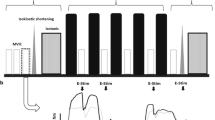Abstract
New experimental and clinical data on the function of the ligamentum capitis femoris (LCF) and its participation in maintaining an erect posture were obtained. It was established that this anatomical element is involved in constraining the hip joint adduction and may fix the joint in the frontal plane, turning it into an analogue of a second-class lever. In both unstrained one-suport and symmetrical two-support orthostatic postures, when the LCF is stretched and the abductor muscle group is exerted, a load equal to the body weight is evenly distributed between the upper and lower hemispheres of the caput femoris. In addition, the LCF function increases the steadiness of the erect posture and unloads the muscle apparatus.
Similar content being viewed by others
References
Kovanov, V.V. and Travin, A.A., Khirurgicheskaya anatomiya nizhnikh konechnostei (Surgical Anatomy of the Lower Limbs), Moscow, 1963.
Sinel’nikov, R.D., Atlas anatomii cheloveka (Atlas of Human Anatomy), Moscow: Meditsina, 1972, vol. 1.
Vorob’ev, V.P. Anatomiya cheloveka: Rukovodstvo i atlas dlya studentov i vrachej (Human Anatomy: A Guide and Atlas for Students and Physicians), Moscow: Medgiz, 1932, vol. 1.
Tonkov, V., Anatomiya cheloveka: Obshchaya chast’: Sistema organov dvizheniya (Human Anatomy: The General Part: The System of Locomotory Organs), Liningrad: Medgiz, 1946.
Orletskij, A.K., Malakhova, S.O., Morozov, A.K., and Ogaryov, Ye.V. Artroscopicheskaya chirurgia tazobedrennogo sustava (Arthroscopic Surgery of the Hip Joint), Moscow, 2004.
Byrd, J.W., Operative Hip Arthroscopy, New York: Thieme, 1998.
Ruhmann, O., Borner, C. von Lewinski, G., and Bohnsack, M., Ligamentum Teres, Orthopade, 2006, vol. 35, no. 1, p. 59.
Vezalii, A., Epitome, izvlecheniya iz sovikh knig o stroyenii chelovecheskigo tela: perevod s latinskogo (Epitome: A Review of My Books on the Structure of the Human Body: Translation from Latin), Moscow: Meditsina, 1974.
Gayevskaya, L.I., Topographic Anatomical Features of the Ligament Apparatus in the Hip Joint and Their Significance for the Clinical Picture, Cand. Sci. (Med.) Dissertation, Leningrad, 1954.
Neverov, V.A. and Shil’nikov, V.A., Sposob fornirovaniya iskusstvennoj golovki bedra pri endoprotezirovanii (Method of Formation of an Artificial Ligamentum Capitis Femoris in Endoprosthetics), Vestn. Khir., 1993, no. 7–12, p. 81.
Vorob’ev, N.A., Svyazka golovki bedra i yeye prakticheskoye znachenuye (The Ligamentum Capitis Femoris and Its Practical Importance), in Voprosy travmatologii i ortopedii (Problems of Traumatology and Orthopedics), Kiev, 1962, p. 174.
Yurchak, V.F., and Yevtushenko, V.A., Morphological Features of the Fetal Hip Joint in the Second Half of Pregnancy, Ortoped. Travmatol, 1972, no. 1, p. 26.
Nikolaev, L.N., The Role of the Orbicular Ligament in the Hip Joint, Med. Zh., 1922, vol. 3, no. 1–2, p. 10.
Ivanitskii, M.F., Anatomiya cheloveka s osnovami dinamicheskoy i sportivnoy morfologii: Uchebnik dlya institutov fizicheskoy kultury (Human Anatomy with Essentials of Dynamic and Sports Morphology: A Textbook for Colleges of Physical Education), Leningrad: Fizkultura i Sport, 1985.
Nedrigailova, O.V. Essentials of Locomotorium Biome-chanics in Health and Disease, in Mnogotomnoye rukovodstvo po ortopedii i travmatologii (A Multivolume Guide on Orthopedics and Traumatology), Moscow: Meditsina, 1967, vol. 1, p. 169.
Belen’kij, V.E., Some Problems in Hip Joint Biomechanics, Cand. Sci. (Med.) Dissertation, Moscow, 1962.
Shapovalov, V.M., Shatrov, N.N., Tikhilov, R.M., et al., The Load Pattern in the Hip Joint in Acetabular Dysplasia and Caput Femoris Osteonecrosis, Travmatol. Ortoped. Ross., 1998, no. 3, p. 22.
Yanson, H.A., Biomekhanika nizhnei konechnosti cheloveka (Biomechanics of the Human Lower Limb), Riga: Zinatne, 1975.
Bombelli, R., Structure and Function in Normal and Abnormal Hip: How to Rescue Mechanically Jeopardized Hip, Berlin: Springer, 1993.
Pauwels, F., Gesammelte Abhandlung zur funktionellen Anatomie des Bewegungsapparates, Berlin: Springer, 1965.
Author information
Authors and Affiliations
Additional information
Original Russian Text © S.V. Arkhipov, 2008, published in Fiziologiya Cheloveka, 2008, Vol. 34, No. 1, pp. 89–95.
Rights and permissions
About this article
Cite this article
Arkhipov, S.V. On the role of the ligamentum capitis femoris in the maintenance of different types of erect posture. Hum Physiol 34, 79–85 (2008). https://doi.org/10.1134/S036211970801012X
Received:
Published:
Issue Date:
DOI: https://doi.org/10.1134/S036211970801012X




